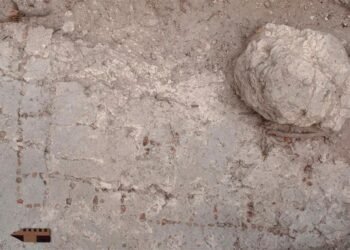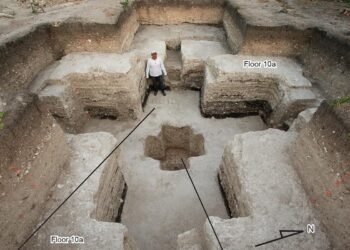Archaeologists working on the west coast of Norway have uncovered a Viking Age burial site at Skumsnes farm in Fitjar. This site, believed to date back to the early 9th century, has revealed a wealth of artifacts that shed light on the lives of high-ranking Viking women and their roles in society. The findings include rare jewelry, silver coins, textile tools, and unique grave markers.

The discovery began with metal detector enthusiasts unearthing a coin and a brooch at the site, prompting further excavations by archaeologists from the University of Bergen. Søren Diinhoff, an archaeologist from the University Museum of Bergen, described the site as “a small treasure trove” during an interview with Science Norway.
Among the remarkable finds are three graves, two of which belonged to women of high status. One grave contained costume jewelry, including oval brooches used to fasten apron dresses, glass beads, and rare coins. The centerpiece is a coin believed to originate from the Danish Viking towns of Hedeby or Ribe, described by Diinhoff as “the most remarkable find here.” Other coins, identified as Carolingian silver from the Frankish Empire, further underscore the women’s connections to continental Europe.
One of the most intriguing graves features stones arranged in the shape of a boat, complete with rivets from a 13-foot-long vessel. This grave also contained tools for textile production, including a weaving sword, spindle whorl, and wool shears. “Textile production was prestigious. Farms that made fine clothing held high status,” Diinhoff explained, noting that these items highlight the woman’s role as both a household head and a key figure in the farm’s economy.

Adding to the mystery is a bronze key found in the grave, symbolizing authority and control over the household. Unn Pedersen, a Viking Age expert from the University of Oslo, stated that they reflect a combination of jewelry and tools emblematic of elite Viking women. She added, “Through textile work, women could accumulate wealth during the early Viking Age.”
While the graves are rich in artifacts, no human remains have been found, a phenomenon attributed to the acidic soil of western Norway, which consumes bone over time. However, one grave raises questions about traditional burial practices. Archaeologists found coins and beads atop a decaying organic mass, possibly a leather pouch, suggesting the items were not worn by the deceased. This discrepancy led to speculation that the grave might be a cenotaph—a memorial rather than a burial.
A unique feature of this grave is a stone, placed where the mast of the boat would have been, resembling female genitalia. Diinhoff referred to this as a “vulva stone,” theorizing that it might symbolize the woman memorialized in the grave. “That the stone resembles [genitalia] is no coincidence. It’s so obvious,” he remarked.

The strategic location of Skumsnes along the coast likely made it an essential stopover for travelers and a source of income for local rulers. According to Diinhoff, the site probably belonged to a farm associated with a local or regional king. The presence of jewelry and coins from England, Ireland, and the Frankish Empire highlights the extensive trade networks of the Viking Age.
Pedersen also noted the transformation of military equipment, such as a Carolingian sword belt fitting repurposed into a brooch, as evidence of the Vikings’ adaptive craftsmanship. “This shows how military equipment from France was repurposed into jewelry in Scandinavia,” she explained, emphasizing the cultural exchanges that characterized the period.
While the discovery at Skumsnes is groundbreaking, Diinhoff expressed concern about the loss of similar sites. Many Viking graves remain unreported or are destroyed during farming activities. “We’re losing an immense number of these graves,” he warned, urging landowners to report such finds for preservation.
Despite these challenges, the Skumsnes excavation is a significant step forward in understanding Viking society, particularly the roles and status of women. As Pedersen concluded, “These graves are typical examples of wealthy women’s graves from the Viking Age, showing their high social and economic standing.”
More information: Science Norway























